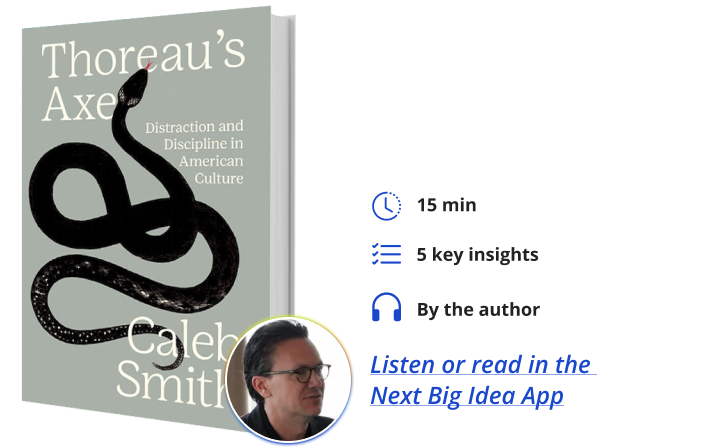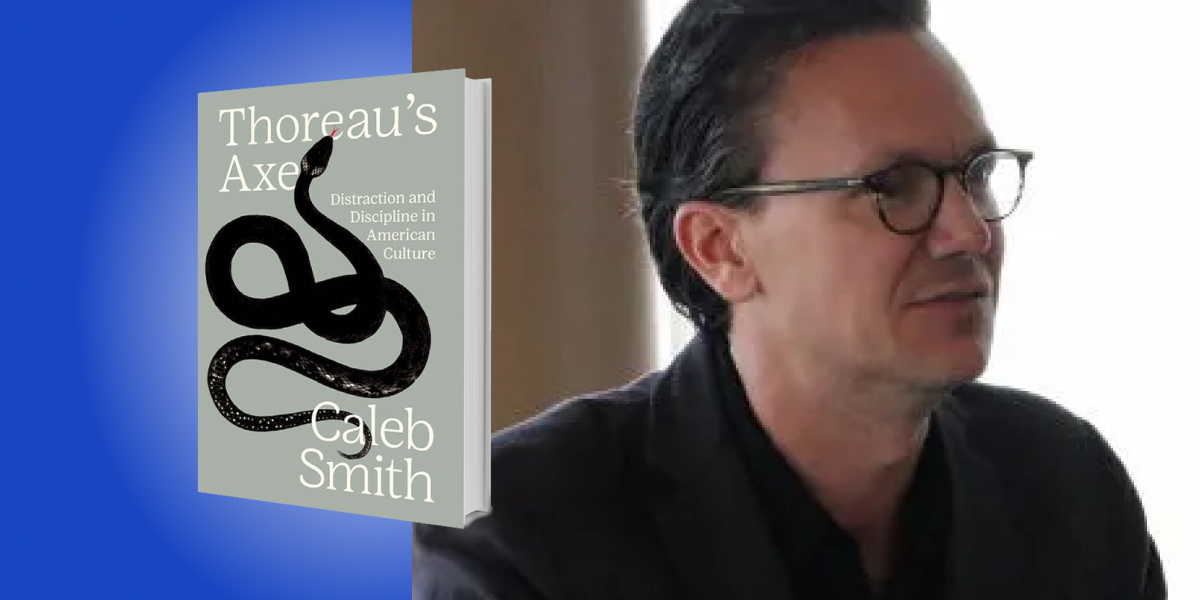Caleb Smith is a Professor of English and American Studies at Yale University, teaching courses about American literature, religious traditions, and legal and cultural institutions. This is his fourth book to explore his primary research interest in the culture of discipline in the United States.
Below, Caleb shares five key insights from his new book, Thoreau’s Axe: Distraction and Discipline in American Culture. Listen to the audio version—read by Caleb himself—in the Next Big Idea App.

1. In our society, distraction always seems to call for discipline.
Thoreau’s Axe is a book about distraction, the feeling that your mind is wandering and drifting away from what really matters. It’s also a book about discipline, especially self-discipline—all of the ways that people try to rehabilitate and retrain themselves out of distraction, to cultivate better concentration and presence of mind in a distracting world. I call these kinds of training and self-training disciplines of attention.
These days, if you look around—flipping through the channels, reading a newspaper, or browsing the self-help aisle at a bookstore—you can see that anxieties about distraction are all over the place. People are worried about shorter attention spans, about too much information and disinformation, about all the ways that our thoughts are manipulated, how our attention is being directed and redirected by our employers, our markets, and our media, especially online social media.
You’ll also see how people keep proposing the same kind of solution. It always seems to come down to discipline. For instance, they tell you that you’ve got to break bad mental habits and learn better habits, and to get there, you’ve got to practice new mental or spiritual exercises, styles of meditation or mindfulness, or ways of focusing your attention.
They might tell you that you can use these techniques to improve mental health. Or improve personal relationships. To become more creative, or achieve greater productivity at work.
After a while, you might wonder: how long has this been going on? If discipline is the solution to distraction, why hasn’t it worked? In our consumer society, advertisers are good at creating and stoking new desires, even new needs, to keep us shopping for new products. All that stimulation is a big part of our distraction. But as we keep hearing sales pitches for new disciplines of attention, we might have some doubts about whether the marketplace that creates and benefits from our distraction can really promise to heal us from it. So: how can we think outside this cycle, the loop that keeps us traveling the circuit from anxious distraction to self-discipline and back again?
2. Distraction has a history—so does attention.
I try to see distraction and the disciplines of attention within a history that goes back long before cell phones and social media platforms. As a matter of fact, you could go back almost forever. Scholars who study the practices of classical philosophers, or who explore the prayer regimens of medieval monks, will remind us that people have been struggling against distraction for thousands of years.
“These traditions help us understand that the problem of distraction is not exactly a new one.”
Ancient philosophers developed sophisticated techniques to train and guide their own attention. They wanted to detach their minds from the cares and passions of what they called this world, the material and social world of everyday life; they wanted to turn their attention to higher, eternal, spiritual matters. Even now, lots of writers and attention gurus call back to those ancient traditions as sources of inspiration.
My book goes back only two or three hundred years, not two or three thousand, but I do look into some efforts to revive older religious traditions. For many centuries, when Christians thought about the sources of distraction, they didn’t think about video games or newspapers; they thought about the devil, demons, or sin.
One minister in the early 1700s gave a sermon exploring the question, when is distraction a sin? The minister’s lesson was that people could overcome the devil’s distractions by exercising free will—for instance by concentrating on the sermon that the minister was preaching just then.
These traditions help us understand that the problem of distraction is not exactly a new one. But there’s also a risk in seeing distraction as something that has always been with us and always will be, as part of our human nature. Paradoxically, this way of thinking leaves us back where we started, with the sense that distraction can only be overcome through personal discipline. Or else, after the rise of secular, scientific understandings of our human nature, it leaves us with the sense that distraction is a medical problem, best left to doctors and pharmaceutical companies.
Thinking historically means seeing distraction as an old problem, but one that has changed over time, under different conditions.
3. Around two hundred years ago, new economic systems and new technologies created a new understanding of distraction.
The title of my book comes from a passage from the great American writer and naturalist Henry David Thoreau. As you probably know, in the 1840s Thoreau famously went to live by himself in the woods on the shores of Walden Pond, outside Concord, Massachusetts. But something happened just as he was getting started: while he was cutting some white pines to build his little house, his mind began to wander, and he broke the axe that he had borrowed from a friend.
Thoreau had to repair the axe, and this led him to do some soul-searching about his own state of mind. Thoreau ended up writing some passages about distraction and attention that still resonate today. For instance, he wrote about new technologies: “our inventions are wont to be pretty toys, which distract our attention from serious things.” He also talked about how the human mind can be, as he put it, “permanently profaned by the habit of attending to trivial things.”
“Thoreau was also saying something new: that the sources of distraction are not in our human nature; they are artificial.”
In some ways, Thoreau sounded like an ancient philosopher or a religious mystic, and he did know about those traditions. But Thoreau was also saying something new: that the sources of distraction are not in our human nature; they are artificial; they are in the economy, in modern systems of production and consumption, in the ways we work and in the ways we try to entertain ourselves. Already in Thoreau’s lifetime, industry was making new demands on workers’ attention in factories and workshops. Commerce was making new demands on consumers’ attention in advertising, the news media, and the marketplace.
Thoreau is sometimes remembered as a hermit, but he was far from alone. Lots of other writers, people of faith, and activists felt the same way. As far away as Louisiana, a Creole poet and mystic named Adrien Rouquette called the nineteenth century an “age of machines and money.” In Philadelphia, a judge and reformer worried about “the wayward and restless youths who…throng the places of cheap and vulgar amusement in which the city abounds.”
Nineteenth-century thinkers came to see distraction more or less as we do now: as an effect of modern economic and technological forces. But then, at the same time, while they were updating their theory of distraction as a problem, they kept turning back to the same old solution—back to discipline.
4. Attention training became a form of social control.
This might sound strange. Nowadays we are most likely to feel manipulated by algorithms that distract us, keeping us flitting from site to site, rather than training us to pay attention in a sustained way to just one object. But to understand distraction, we have to understand why people want it, and why distraction sometimes feels like freedom or a temporary escape. The reason is that lots of powerful people and institutions do try to control and guide our attention. In the nineteenth century, this was happening on slave plantations, where the overseer represented a vigilant kind of surveillance over the discipline of enslaved laborers. It was going on in factories and workshops, which were developing their own new techniques of management to keep workers from becoming distracted. It was happening in churches and evangelical revivals.
“To understand distraction, we have to understand why people want it, and why distraction sometimes feels like freedom or a temporary escape.”
And it was happening in disciplinary institutions, too—in penitentiaries, in juvenile reformatories, and in an expanding network of schools for the children of the poor. I spent some time with the history of the Massachusetts Reform School, the nation’s first state-run juvenile reformatory, which was built in a rustic setting, far from factories and the distractions of urban life, overlooking a little pond. The state had the same theory of distraction and attention that took Thoreau to Walden at just the same time, but it used this theory to build a youth prison.
Police and prisons helped to defend private property, and meanwhile, juvenile reformatories helped to train young people for the rigors of labor in the new industrial economy. Those institutions are obviously coercive. But even private, voluntary regimens of self-discipline or self-care can serve a similar purpose, either by helping people cope with the stress or by becoming commodities, just so many more products for sale in a marketplace full of distractions.
5. If distraction is an effect of economic conditions, so is attention.
What took shape in the nineteenth century was a predicament that we’re still stuck in now: even when we understand that distraction’s real causes are in the large-scale economic systems and technologies that shape our world, we keep trying to solve the problem with personal disciplines. Whether these disciplines are imposed by institutions or taken up voluntarily, their function is to privatize the rehabilitation of our own attention. Even when we know that big business is causing and profiting from our distraction, we feel guilty, and we make ourselves personally responsible.
Sometimes, this responsibility looks like repression, as in the case of a youth prison. Sometimes it can be quite strange and beautiful, as in the many spiritual exercises and practices of devotion that are recorded in our literature. Reading that literature is my own discipline of attention. But one important conclusion we can draw from history is that real attention requires some free time and some shelter, which are harder and harder to come by in the modern economy. People need more control over their own time and more protection from manipulation. To deal with the problem of distraction, we would have to transform our economic conditions, not just ourselves.
To listen to the audio version read by author Caleb Smith, download the Next Big Idea App today:
































